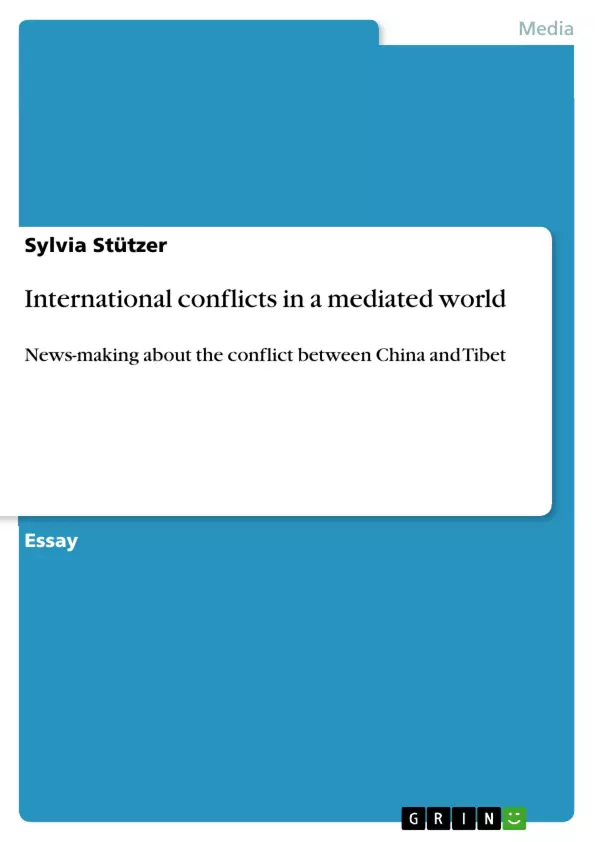1 Introduction
The process of Globalization and new communication technologies such as television and internet provide advanced opportunities for the mass media to report about conflict and war in any remote part of the world beyond national borders. The public opinion and people’s perception of a conflict can be shaped by news coverage, in many cases imprinted by the relationship between the media and the political elite which is especially consistent in times of war (Hallin 1986, cited in Dimitrova and Strömbäck 2005: 406). If media coverage is reflecting the line of government officials, images related to war and conflict are biased. This construction of reality by the contemporary mass media is especially criticised, besides other critique, by so-called “corrective forms” of journalism (Cottle 2006: 100-119).
The recently escalated conflict between the People’s Republic of China and its autonomous region of Tibet is perceptible everywhere in the world and not only a national issue behind doors any more as contemporary mass media enhance a form of “global scrutiny” making violent and despotic behaviour of states visible for the world (J.B. Thompson 1994, cited in Stevenson 2003: 107). In fact, the tensions between China and Tibet is not a new phenomena but the riots bring the issue back into the public what proves the statement of Simon Cottle, that the mass media is rather reporting about violent conflicts and has little interest in processes of peaceful resolutions of conflicts (Cottle 2006: 100). The conflict is carried out in the media via “selective, framed communication” and voices stating their opinion on the conflict are raised everywhere in the world.[...]
Inhaltsverzeichnis (Table of Contents)
- Introduction
- Characteristics of contemporary mass media
- New technologies and speeded-up communication
- The fascination of violence and “infotainment”
- The concept of framing
- The critique on mainstream journalism
- “Peace journalism” (Johan Galtung)
- “Understanding not empathy” (Jean Seaton)
- News coverage in China and India on the conflict between China and Tibet
- Conclusion
- References
- Secondary literature
- Indian and Chinese newspapers (alphabetical order)
Zielsetzung und Themenschwerpunkte (Objectives and Key Themes)
This paper examines the news coverage of the conflict between China and Tibet in Indian and Chinese media outlets. The primary objective is to analyze how these media frames the conflict and to explore the impact of framing on public perception. The author aims to demonstrate that framing strategies are at work in all news coverage, regardless of the political context or ideology. The paper focuses on the role of new technologies and "infotainment" in shaping the public's understanding of conflict, as well as the critique of mainstream journalism by "corrective forms" such as peace journalism.
- The influence of new technologies and speeded-up communication on news coverage
- The role of "infotainment" and the fascination with violence in shaping media narratives
- The concept of framing and its impact on public perception of conflict
- The critique of mainstream journalism and the emergence of "corrective forms" such as peace journalism
- The comparative analysis of news coverage in China and India on the conflict between China and Tibet
Zusammenfassung der Kapitel (Chapter Summaries)
The introduction highlights the significance of the China-Tibet conflict in the global public sphere and the impact of media coverage on public opinion. The author emphasizes the growing influence of "global scrutiny" and the tendency of mainstream media to focus on violence and conflict rather than peaceful resolutions. The paper aims to analyze the framing of this conflict in Chinese and Indian media, acknowledging the historical and cultural ties between Tibet and India despite India's recognition of Tibet as part of China.
Chapter 2 examines the characteristics of contemporary mass media, focusing on the impact of new technologies and the rise of "infotainment." The author discusses the accelerated information flows and the challenge of maintaining depth and reflection in a fast-paced news environment. The chapter also explores the media's fascination with violence and the potential for "infotainment" to overshadow serious journalism.
Chapter 3 delves into the critique of mainstream journalism, presenting "peace journalism" as a form of corrective journalism aimed at improving war and conflict reporting. The author highlights Johan Galtung's influential contributions to peace and conflict research and his advocacy for a more constructive approach to journalism. The chapter also examines the criticisms levied against peace journalism, particularly regarding its media-centric focus and potential limitations in addressing complex sociopolitical issues.
Schlüsselwörter (Keywords)
Key terms and topics explored in this paper include news-making, globalization, media framing, infotainment, peace journalism, violence, conflict resolution, China, Tibet, India, and public opinion. The author examines the influence of new communication technologies, the role of media in shaping perceptions of conflict, and the emergence of alternative journalistic approaches to address the shortcomings of mainstream media coverage.
- Quote paper
- Dipl.-Pol. Sylvia Stützer (Author), 2008, International conflicts in a mediated world, Munich, GRIN Verlag, https://www.grin.com/document/138768



